Want to learn how to play the piano? You’ve come to the right place!
With 88 keys, a rich history, and many associated celebrities, the piano can be an intimidating instrument. But it’s also an accessible one. Anyone can learn the piano at any age and have hours of fun on it.
This comprehensive series will take you from never touching the piano to playing your first chords and first song. You’ll also learn fundamental skills, good habits, and some shopping tips.
Table of Contents
Getting Started
Chapter 1: Before You Start
1.1 Why Learn How to Play the Piano? (5 Reasons)
1.2 What to Expect: Time, Cost, etc.
1.3 Learning Piano as an Adult
Chapter 2: Shopping Guide
2.1 Buying Your First Piano or Keyboard
2.2 Piano Accessories and Maintenance
2.3 Learning Methods
Mastering the Fundamentals
Chapter 3: Take a Seat!
Chapter 4: Basic Skills
4.1 Navigating the Keyboard and The Musical Alphabet
4.2 The Five Finger Scale
4.3 Your First Chords
4.4 Playing with Both Hands
4.5 Playing Scales with Both Hands
Music Theory
Chapter 5: The Grand Staff
5.1 How to Read Music
5.2 Music Symbols
Chapter 6: More About Chords
6.1 How Chords Work
6.2 How to Use Chord Charts
6.3 How to Use Lead Sheets
Chapter 7: Your First Songs!
7.1 Easy Piano Songs to Learn First
Next Steps
Chapter 8: Exploring Genres
8.1 Jazz Piano
8.2 Worship Piano
8.3 Classical Piano
8.4 Pop Piano
Chapter 9: FAQ and Resources
Get exclusive interviews, fascinating articles, and inspiring lessons delivered straight to your inbox. Unsubscribe at any time.

If you’re reading this article, you’re probably already excited to learn how to play piano! But in case you’re not convinced yet, this section is for you 🙂
We think the piano is the best musical instrument to learn. Of course, we’re biased as pianists, but there are compelling reasons to pick up piano as your first musical instrument:
Some instruments, like the violin or the trumpet, take skill just to make a decent sound.
But piano is rewarding from day 1 because you don’t have to “make” the sound yourself. All you have to do is press a key that’s attached to a hammer that hits a string to create a perfectly clear note.
Most people can figure out a simple melody on a keyboard by playing around. Of course, there’s more to playing piano than eking out “Twinkle, Twinkle Little Star,” but at least you won’t be squeaking through your first few lessons!
A neat thing pianists can do is play both melody and harmony. Most instruments can’t do this.
As a pianist, you’ll gain a deeper understanding of both melody and harmony — that is, both the foreground and background of music.
Knowledge of both treble and bass clef also helps. Many instruments only use the treble clef, but if you decide to pick up the tuba later on, that bass clef knowledge will come in handy.
Since pianos handle both melody and harmony, you don’t require someone to accompany you. Other instruments, such as the violin or guitar, require bands, backing tracks, or an accompanying pianist to sound “complete.”
But pianists aren’t doomed to be alone! Pianos are a pillar instrument in many ensembles, from jazz bands to church worship teams. If you play piano, we encourage you to jam with other musicians. It’s a wonderful experience.
Whether it’s classical, jazz, blues, boogie-woogie, rock, pop, or experimental avant-garde stuff, the piano can handle them all.
Now, the skills required for different genres can be very different. But you don’t need a whole different instrument (such as going from steel-string to nylon-string guitar) to learn a new genre.
Because piano requires fine motor skills, knowledge of both treble and bass clefs, and good musicality, when you learn piano, you gain transferable skills for other instruments.
Since learning piano, I’ve learned flute, electric and acoustic guitar, electric bass, and a few basic drum patterns. I believe these instruments were definitely easier to learn because I had piano skills as a foundation.

This is a legitimate question. After all, no musical instrument is perfect.
I can think of two potential things pianists have to watch out for.
These aren’t unfixable problems, though. To develop a good ear, actively listen to lots of music, gain a deep understanding of chords and harmony, and learn how to play by ear.
We also encourage you to find a community with other pianists and musicians. Community is something we’re very passionate about at Pianote, which is why we’ve created an online space for students to gather, discuss, and troubleshoot.
Playing piano isn’t cheap. And it does take up time.
We want you to be prepared and know what to expect. In this section, we’ll go over the cost of making piano a part of your life, as well as the time commitment involved in becoming a competent pianist.
The core costs of learning piano include:
Your instrument will likely be your biggest cost, but there are plenty of options. Some pianos cost as much as a luxury car while entry-level keyboards can cost just a few hundred dollars.
You may also be able to grab a piano for free or very low-cost if you buy used!
Piano instructors can cost anywhere from $20 to $100+ per hour, and you should factor in transportation too. However, online piano lessons (like the Pianote Method) can be significantly cheaper. We’ll discuss the advantages and disadvantages of online vs. “in real life” lessons in the Shopping Guide.
Unlike other instruments with amplifiers and moving parts, accessories for the piano are mostly optional. But you’ll likely need a metronome, a few books, a music stand and pedal (if your piano doesn’t have those), and some hardware and software if you want to record yourself.
If you buy an acoustic piano, you’ll have to hire someone to tune it once in a while. But electric keyboards don’t need a lot of maintenance.
You’ve probably heard stories of professional pianists practicing an insane amount of hours from a very young age.
The piano has a long history, and the caliber for performers today is very high. If you plan to become a professional pianist, expect to practice a lot.
But you don’t need to practice eight hours a day to jam with a band, lead your church worship team, or even teach beginners. If you just want to play your favorite songs and have fun, practicing 15 minutes a day will allow you to progress.
Of course, in general, the more you practice, the faster you’ll improve. But practicing is less about putting in the hours and more about honing the right skills.
The awesome thing about piano is that you don’t need to be a top-level performer to reap incredible rewards. Pop songs can be as easy or difficult as you want them (see 5 Levels of Tiny Dancer for an example of this!). And even classical icons like “Für Elise” are considered intermediate pieces.
Are you too old to learn the piano? Nope! If you’re an adult beginner, you may actually have several advantages:
Adults tend to be purpose-driven. Whether it’s a song or a skill, you’re in charge of what you want to learn — not your parents or teachers! And when you’re in charge, you’re more motivated to take initiative.
Adults understand hard work. After a lifetime’s experience with responsibilities (school, work, childcare, etc.), you understand what it takes to learn something new.
Adults can manage their time. While adults are busy people, they also have initiative, which makes them perfect for self-paced learning. It only takes 15 minutes a day of practicing to see results.
Adults already know music. Unless you never listen to music ever, chances are you’ve had more exposure to music than most children. If you know how to keep a beat and sing a melody, you’re well on your way to success.
For an encouraging discussion on learning piano as an adult, watch this video where Lisa shares some exercises you can get started on right away to kickstart your learning.

Buying your first piano or keyboard can be exciting and overwhelming at the same time. Here are a few things to keep in mind:
What is your budget? The price range for pianos and keyboards is huge. There are keyboards going for less than $150 on Amazon. Meanwhile, concert grands can net six digits.
How much space do you have? Measure the area you intend to fit your piano in and bring your measurements to a store.
Who do you live with? If you live with roommates, family, or in an apartment building, you may want to choose a piano you can use headphones with. Many acoustic pianos also come with a quiet practice pedal.
Acoustic, digital, or hybrid? The sound quality of an acoustic piano is unparalleled, but digital pianos and keyboards are way more affordable and often come with useful features. A hybrid piano has elements of both.
Rent or buy? If you’re uncertain about committing to the piano, you may want to rent one first. You may also be able to find affordable, high-quality second-hand pianos.
There are so many products available — how do you know what features to prioritize? We have the following recommendations:
If you’re still stuck, check out Lisa’s gear recommendations.
Pianos are pretty self-contained. But you may have a more rewarding experience if you invest in a few accessories.
Piano bench. Unless you plan to use your piano like a standing desk, having something to sit on is a must. While any old chair will work in a bind, a specialized piano bench gives you plenty of space to maneuver your body. Many piano benches are height-adjustable and offer storage, too.
Pedal. If your keyboard doesn’t come with a pedal, we highly recommend you invest in one. Pedaling makes a big difference and can even help you sound better when you’re first learning a song.
Metronome. If you want to bring your playing to the next level, expect to practice with a metronome. You can buy a stand-alone metronome, download an app, or even search Google for “metronome” and use their free tool.

Music stand. Most pianos come with a built-in stand. If yours doesn’t, invest in a hardy stand that can hold up sheet music, books, metronomes, and stationery.
Recording equipment. Recording and then hearing yourself play can make a big difference in improving your technique. Many keyboards come with built-in recording capability. Otherwise, you may want to invest in a microphone and some software.
Tuning. Acoustic pianos need to be tuned by a professional and this will cost between $100 and $200.

Other than your piano, this is probably your most important investment.
Not too long ago, the only way to learn piano was to visit a teacher once a week. Today, thanks to the Internet and new technologies, we have many more options.
Let’s take a look at the pros and cons of three major ways of learning: in-person lessons, app learning, and online learning.
| Pros | Cons |
|---|---|
|
|
| Pros | Cons |
|---|---|
|
|
| Pros | Cons |
|---|---|
|
|
Of course, we at Pianote are biased towards the Pianote online learning method. But we wouldn’t be here if we didn’t believe in our method.
The Pianote learning experience was crafted as a “best of both worlds” solution. Here’s a comparison between traditional lessons and Pianote to give you an idea of what we offer:
| TRADITIONAL LESSONS | PIANOTE |
|---|---|
| In-person, personalized attention | Personal attention through Student Focus and contacting instructors |
| Can add up to $1700+ per year | Starting at $200/year |
| Weekly lessons (you won’t see your teacher every day) | Learn as often as you like, whenever you like |
| No built-in community | Immediately be welcomed into the Pianote student community! |
| Unlikely to offer extended free trial | 90-day money-back guarantee |
| May be against local Covid-19 restrictions | 100% virtual and socially distant |
If you’re on the fence about joining Pianote, take a peek at the membership here.
If online, traditional, or app learning doesn’t cut it for you on their own, try combining methods. For example, you could take lessons with Pianote and connect with an in-person instructor once a month.
Whichever method you decide on, keep these two things in mind:
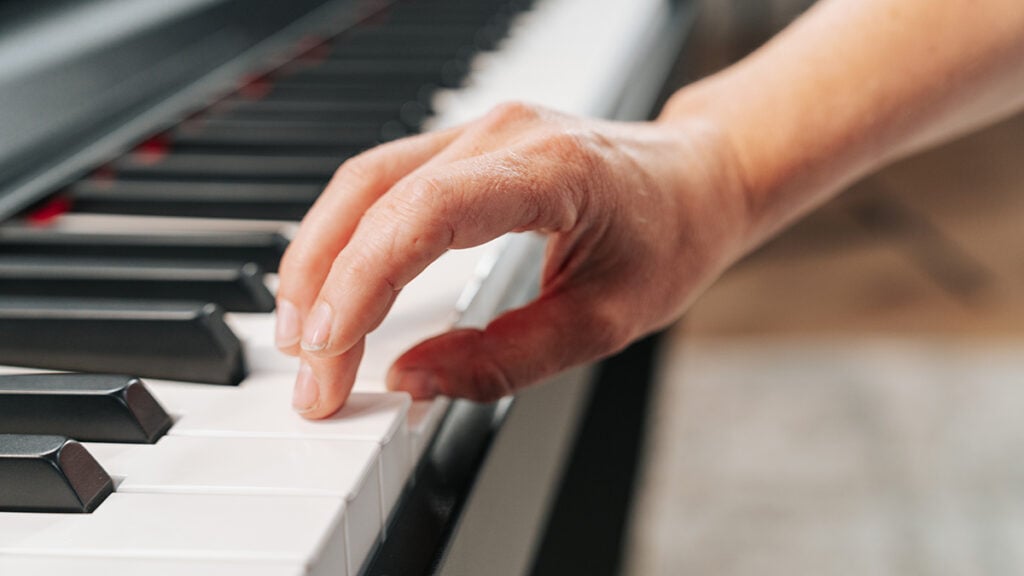
Good habits start from day one. Before you start playing, always stretch, warm up, and check your posture.
Sit down on your bench facing the middle of the piano. Make sure your feet are flat on the floor, your shoulders relaxed, and your arms are gently bent at the elbow.
Remember these posture tips:
When you place your hands on the keyboard, relax your wrists. Don’t tense your fingers—keep them loose so that they’re slightly bent, not straight. Be careful not to let your wrists droop.
Good posture is essential to enjoying your time at the piano. If you’re comfortable, you’ll be more motivated to practice, and you’ll play with better technique too.
The piano keyboard may look dizzying with its vast array of keys (88, to be exact). But once you understand the patterns that make it work, it’s actually quite simple.
Take a look at your keyboard. Notice the black keys—see how there are sets of two and sets of three? We’ll use these sets of twos and threes to find Middle C.
Middle C is the first note you’ll learn on the piano. It’s smack dab in the middle of the keyboard, usually where the brand name of the piano is.
Find a set of two black keys in the middle and play the white key on the very left: this is Middle C!
Remember where Middle C is. You’ll use it to orient yourself around the rest of the keyboard.
Now for your first theory lesson! In music, we name notes after the alphabet. The white key after C is D, the one after is E, and so on. The musical alphabet stops at G, however, so instead of a note called H we just repeat from C again.

If you’re wondering what all those black keys are called, they’re half-steps between the white notes and they’re called sharps or flats. We’ll cover sharps and flats more in the theory section of this guide.
Once you understand the musical alphabet, you can move on to the five-finger scale!
The five-finger scale is a basic skill that will introduce you to a finger movement that is fundamental to piano-playing.
Let’s go back to Middle C. Place your right thumb on Middle C. In piano, we call this finger 1.
Next, place your index finger on the next white key, D. This is finger 2. Place your remaining fingers on the other white keys. This means finger 3 goes on E, finger 4 goes on F, and finger 5 (pinky) goes on G.
Try playing these notes in order (1-2-3-4-5). Then, play it in reverse (5-4-3-2-1). Congratulations, you’ve just played your first C major five-finger scale!
If this feels weird at first, that’s totally normal and okay. It’s a new movement, so it’ll take time to get used to. Your fingers may want to stick together, especially fingers 3 and 4. To improve, challenge yourself to play all five notes as evenly and articulated as you can.
Play the right-hand five-finger scale a few times. Once you get the hang of it, move on to the left hand.
Find the C below Middle C and place your left pinky (finger 5) on it. Then follow up with the rest of your left-hand fingers.
Again, play these notes up and down a few times until it feels more familiar.
But…how do pianists play more than five notes in a row without running out of fingers?!
This happens quite often, especially with scales. Pianists use techniques like tucking under and crossing over to quickly play long, unbroken streams of notes. This is why practicing scales is so important for pianists who want to play faster.
Chords are the building blocks of music. They’re used in most Western music traditions, including pop, jazz, and church songs. Understanding chords will help you progress in piano on both the practical and theoretical fronts.
Now, there’s a lot of theory behind chords and chord progressions — theory that’s quite fascinating — but to make things simple in this guide, we’ll learn four basic chords in their root position and how to move between them.
The names of the four basic chords we’ll learn are: C major, G major, A minor, and F major.
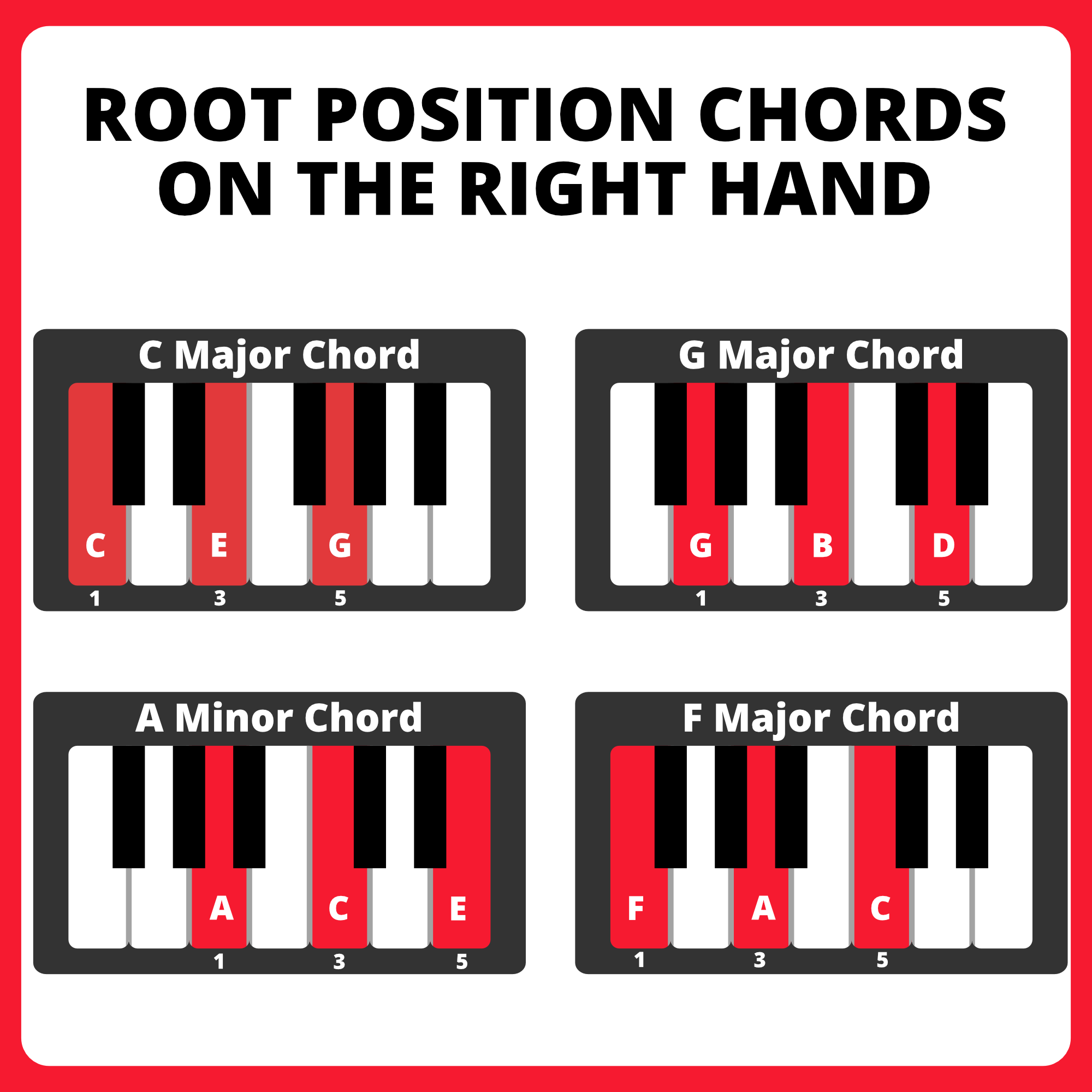
We’ll learn these chords in their triad form in root position, which means they’ll all take a similar “shape.”
On your right hand, place finger 1 (thumb) on C and finger 5 (pinky) on G. Play these notes together. They are the outer “shell” of the C major root position chord. Once this feels comfortable, try playing E with finger 3 (your middle finger).

Try the same thing on your left hand. Place your left-hand finger 5 on C and finger 1 on G to form the chord shell. Then, play E with finger 3.

The same fingering applies to the other root position G major, F major, and A minor chords.
It’s worth repeating: chords are the building blocks of music. Therefore, mastering them will take you to the next level of playing, improvising, and connecting chords with riffs and fills.
Check out our free Chord Hacks lessons for a complete and guided introduction to chords. Otherwise, we’ll revisit chords in a later theory section.
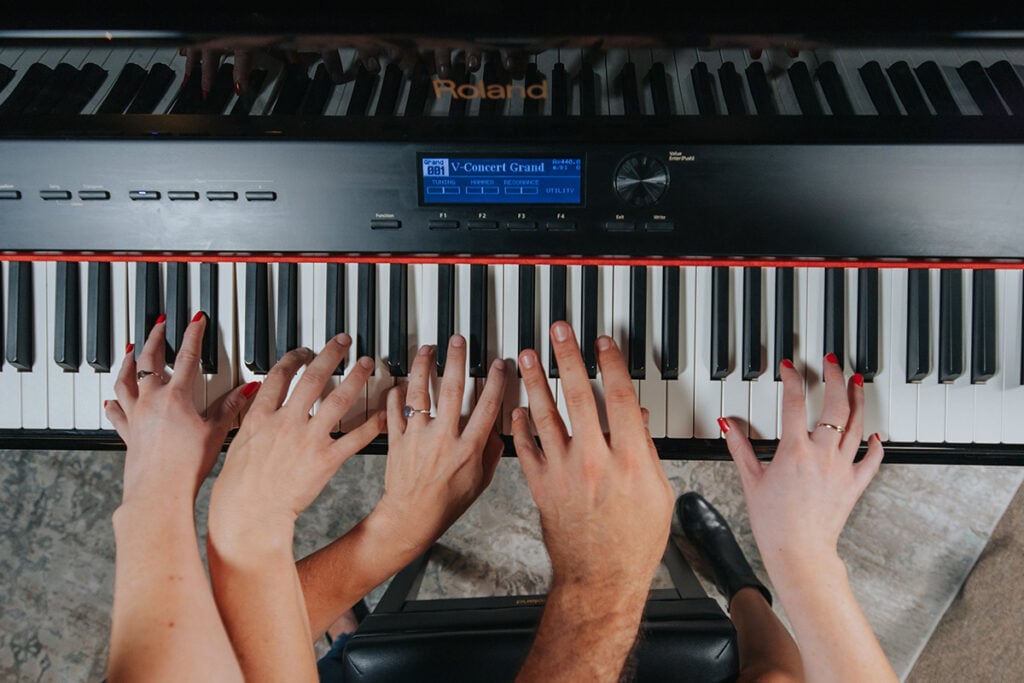
Let’s get one thing out of the way: playing with both hands feels weird. At least at first.
Hand independence is something you’ll continually work on as a pianist. Even advanced pianists have challenges with hand independence.
You already know the five-finger scale. Now let’s try playing it with both hands.
When you play the five-finger scale up with both hands, the fingering with look like this:
Right hand: 1-2-3-4-5 (C-D-E-F-G)
Left hand: 5-4-3-2-1 (C-D-E-F-G)
When you play the five-finger scale down with both hands, the fingering will look like this:
Right hand: 5-4-3-2-1 (G-F-E-D-C)
Left hand: 1-2-3-4-5 (G-F-E-D-C)
If this feels easy, try playing loudly in one hand and softly in the other. Then, switch.
If you’re curious about scales, now is a good time to start.
You’ve mastered the five-finger scale, but what happens when you want to play the entire C major scale, from one octave to the next?
Unless you master the right technique, you’ll run out of fingers! So, before playing hands together, be sure to practice playing a full-octave scale on your right and left hands.
Up:
Notes: C-D-E-F-G-A-B-C
Fingering: 1-2-3-1-2-3-4-5
Down:
Notes: C-B-A-G-F-E-D-C
Fingering: 5-4-3-2-1-3-2-1
Up:
Notes: C-D-E-F-G-A-B-C
Fingering: 5-4-3-2-1-3-2-1
Down:
Notes: C-B-A-G-F-E-D-C
Fingering: 1-2-3-1-2-3-4-5
Putting hands together takes practice. The technique is more easily explained through video, so watch this lesson to get the basics.
Get exclusive interviews, fascinating articles, and inspiring lessons delivered straight to your inbox. Unsubscribe at any time.

You know the musical alphabet. Now let’s learn how to spell some music!
The first thing you should familiarize yourself with is the grand staff:

Most piano music is written on the grand staff. The grand staff is special to the piano because there’s a top and bottom part, usually denoting right and left hands.
We’ll briefly touch on the parts of the grand staff here, but for a more thorough breakdown, we recommend watching this lesson.

Treble Clef
In general, pianists play notes on the top staff, the one with the treble clef, with the right hand.

Bass Clef
Notes on the bottom staff, the one with the bass clef, are usually played with the left hand.
In each staff (treble and bass), there are five lines with spaces between them. This is where our notes sit.

The higher up we move the lines and spaces, the higher the pitch!
Notes occupy lines and spaces and they all have names. At first, it’ll feel intimidating to memorize all the notes and their locations, so these acronyms might help.

Space Notes
Treble clef: FACE
Bass clef: All Cows Eat Grass
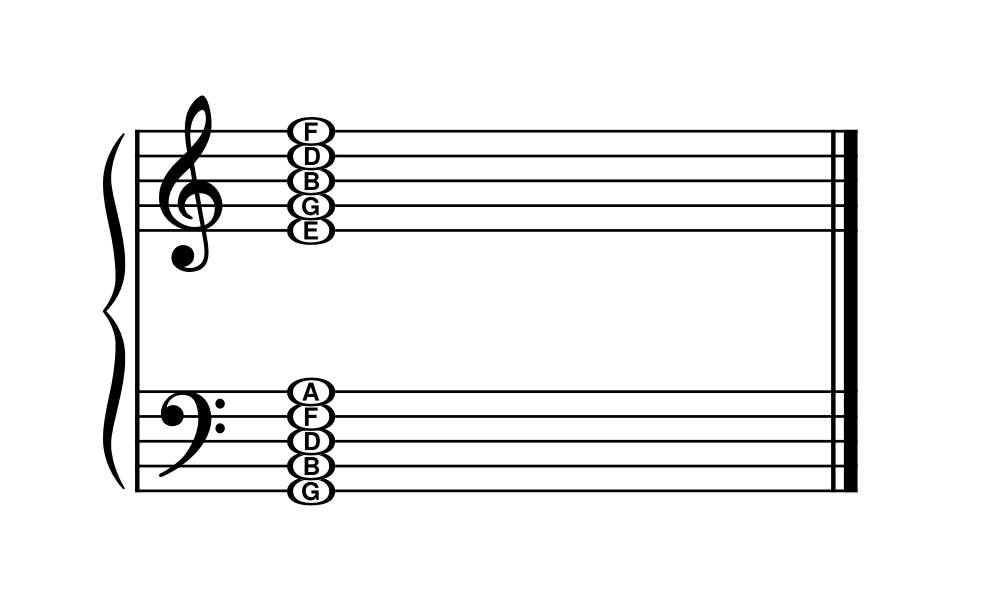
Line Notes
Treble Clef: Every Good Boy Deserves Fries
Bass Clef: Good Boys Deserve Fries Always
But we’re going to let you in on a little secret…
To read music faster, we musicians employ some tips and tricks, such as:
Landmark Notes
Pick a few notes on the staff to know really well, such as G in the treble clef. Then, everything else is just in relation to G. For example, a step up from G is A, and the line note below G is E.
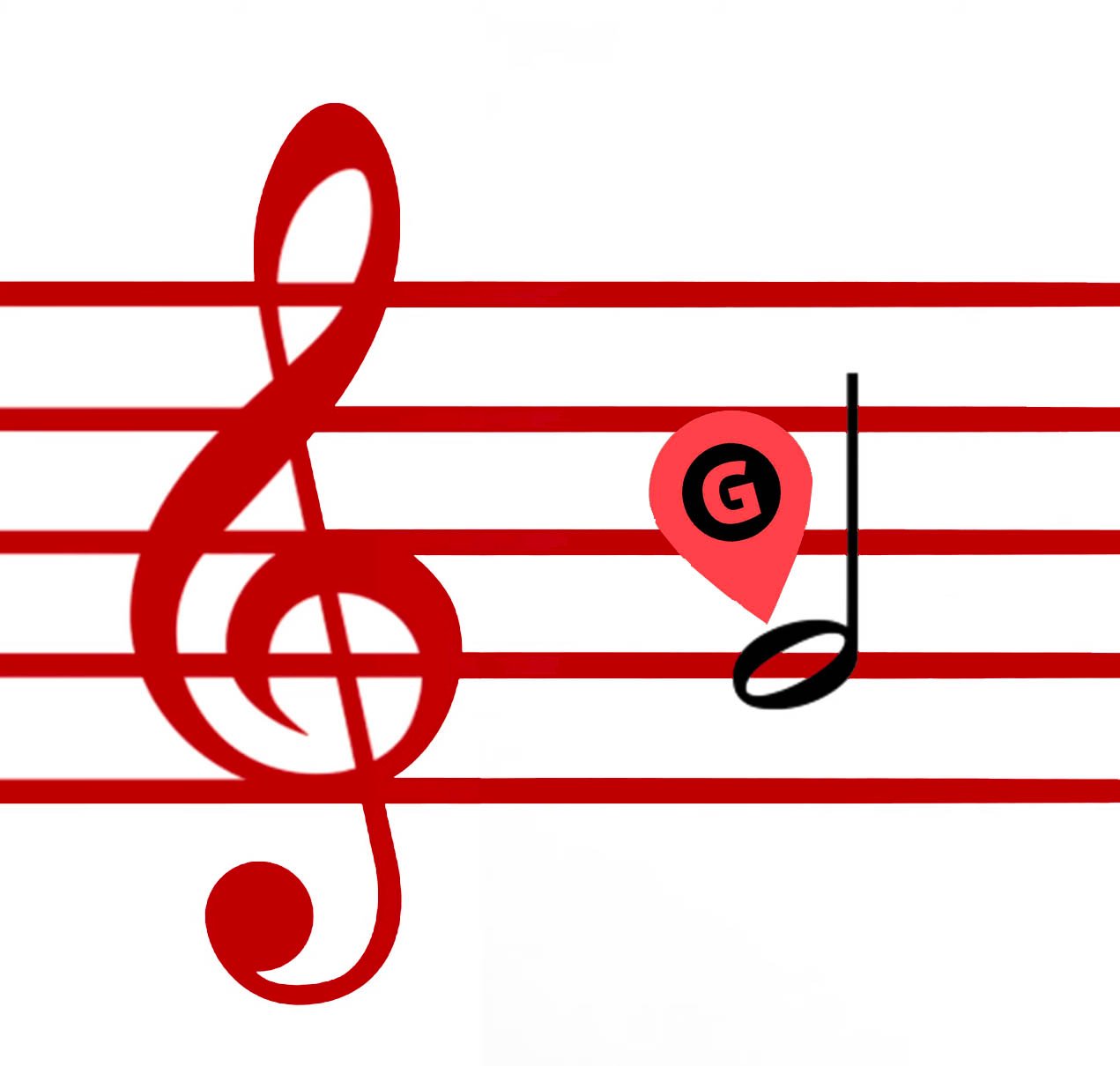
Intervals
Being able to tell the distance between notes is also a shortcut. Beginners should learn how to recognize intervals like thirds (space to space or line to line) and seconds (space to line or line to space).

Patterns
Music is made up of patterns. Knowing how to recognize patterns is a shortcut to reading music. For example, if you can recognize a scale, you’ll know that notes are just going up or down step by step.
This is a section from Mozart’s Sonata in C Major and you can see that it’s really not much more than a scale of notes stepping up and down.

What a note looks like can tell you how many beats it has. In 4/4 time signature, the following notes have this many beats:

These notes have fraction names like quarter note, half note, dotted half note, and whole note.
The time signature consists of two numbers at the beginning of the staff. The top number tells you how many beats there are per measure (a measure section of music enclosed by bar lines). The bottom number tells you what note value takes one beat.

“4” means quarter note so 3/4 means “three quarter notes per measure” and 4/4 means “four quarter notes per measure.”
The key signature is located right before the time signature. It tells you what key you’re in by listing all the sharps and flats (or lack thereof) in the piece.
So, if you see the following key signature, it means all Fs in the piece should be played as F sharp (F#) unless a note has a natural symbol.
To understand the key signature, you’ll need to learn about key. In a nutshell, each key (ie. C major, F sharp minor, B flat major) has a unique number of sharps and flats.
Understanding keys is not absolutely vital when you’re first starting out on the piano, but knowing the Circle of Fifths will come in handy. So check out this lesson if you want to learn more about keys.
You can probably tell that there’s a lot more than notes and staves in sheet music. Here are other things you may run into when sight-reading music.
A sharp means we raise a note up by one half-step. A flat means we lower a note down by one half-step. Therefore, F sharp is the black key immediately right of F, and B flat is the black key immediately left of B.
A natural tells you not to sharp or flat a note.
Accidentals are sharps, flats, and naturals outside the key signature that appear in music. The general rule is, if a note has a sharp (or flat, or natural), all instances of that note thereafter in the same measure should also be sharped.

Dynamics are what makes a good piano performance sound great.
Dynamics are markings that tell players whether to play something loud, soft, or something in between. Here are some common dynamic markings:

Crescendos and decrescendos are the “alligator mouth” symbols that indicate the music should be growing louder or softer.
There are many other symbols that indicate how a piece of music should be expressed. As a beginner, you might run into these:
There are also special words that direct speed (tempo):
It may seem overwhelming to memorize all these words off the bat, especially since most music terms are traditionally in Italian, French, or German. Don’t overwhelm yourself at first! As your exposure to sheet music grows, you’ll naturally pick up the language of music notation. Just learn terms one at a time when you encounter them.
We’ve mentioned that chords are the building blocks of music, but what does this mean?
In a nutshell, a chord is a group of notes played together at the same time, that sound nice together. Chords often have names, like “C,” “Amin7,” or “Gsus4.” I like how classical piano teacher Cassi Falk explains chords and their names:
You can think of [chords] like you would a word in a sentence. When you see the word ‘cat’, you don’t think of the individual letters, c-a-t. You think of the whole system of letters that forms the word and makes you think of a cat. That’s basically the idea with chords.
Cassi Falk, Music Theory for the Dropouts #5

As a beginner, the chords you’re most likely to encounter are triads. These are three-note chords and there are two main types.

Major triads sound “happy.” The middle note can be calculated by counting four half-steps up from the root (bottom) note and the top note can be found by counting three half-steps up from the middle note.

Minor triads sound “sad.” The middle note can be calculated by counting three half-steps up from the root (bottom) note and the top note can be found by counting four half-steps up from the middle note.
The magic of chords happen when we play several in a row, forming a chord progression.
Chord progressions harmonize and move a piece of music forward. You may be surprised to learn that in virtually all of Western music history — from J.S. Bach to Justin Bieber — is based off similar chord progressions.
To see this in action, check out this video (You Love Classical Music – You Just Don’t Know It!).
Once you’re comfortable playing a few chords, check out the I-V-vi-IV progression, which will unlock hundreds (not an exaggeration!) of songs.
A chord chart is a document that shows a song’s lyrics with the names of chords above the lyrics as the chords change.
Knowing how to read and play from a chord chart will take you far. That’s because these days, you can find the chord chart of almost any pop song on Ultimate-Guitar.com for free.

Major chords are indicated by just their letter, like C for C major or F for F major. “Yesterday” begins with a simple F major chord.
Minor chords will have a lowercase “m,” such as the Dm and Em7 chords in “Yesterday.” You can play a lot of songs with just major and minor chords, but other types of chords add color to music.
A slash chord, like F/E in “Yesterday,” means you play the note after the slash as your bass note while your right hand plays the chord F on top.
Standard major and minor chords like Em have a root, third, and fifth (E-G-B). Seventh chords like Em7 have an added seventh (E-G-B-D).
Seventh chords have a dreamier sound and are often used in jazz piano.
No, sus chords are not suspicious. “Sus” means “suspended” and it’s when you switch out a note for another. So Gsus4 would mean switching out the third (B) for a fourth (C) to form G-C-D.
Lead sheets are somewhere between a full score of sheet music and a chord chart. A lead sheet shows you just the melody of a song and the chords above the melody.

Lead sheets are useful because you can confidently play the melody of a song without needing to figure it out by ear, while having ample creative room to experiment with the accompaniment.
The fun comes when you know a melody and the chords well enough to add in your own riffs and fills.
Can you play songs as a beginner? You bet! Here are a few song tutorials to check out
One song we like to recommend beginners try out once they master the fundamentals in Part 2 is “Imagine.” It’s a good song for beginners because it’s in C major (all white keys and no flats or sharps!) and sounds great even when played slowly.
Pop songs are a brilliant place to start because chances are, you’re familiar with the tune already and most pop songs use similar chord progressions. “Someone You Loved” is an iconic song that’s actually very simple. This tutorial will teach you the basics in seven minutes!
> Play Your First Piano Song In 7 Minutes (“Someone You Loved”)
“Happy Birthday” is a simple must-have in your piano playing arsenal. This song is perfect for birthday party sing-alongs. After all, how else can you embarrass your friends on their birthday? In our step-by-step tutorial, we’ll show you a basic way to play this as well as a jazzier version.

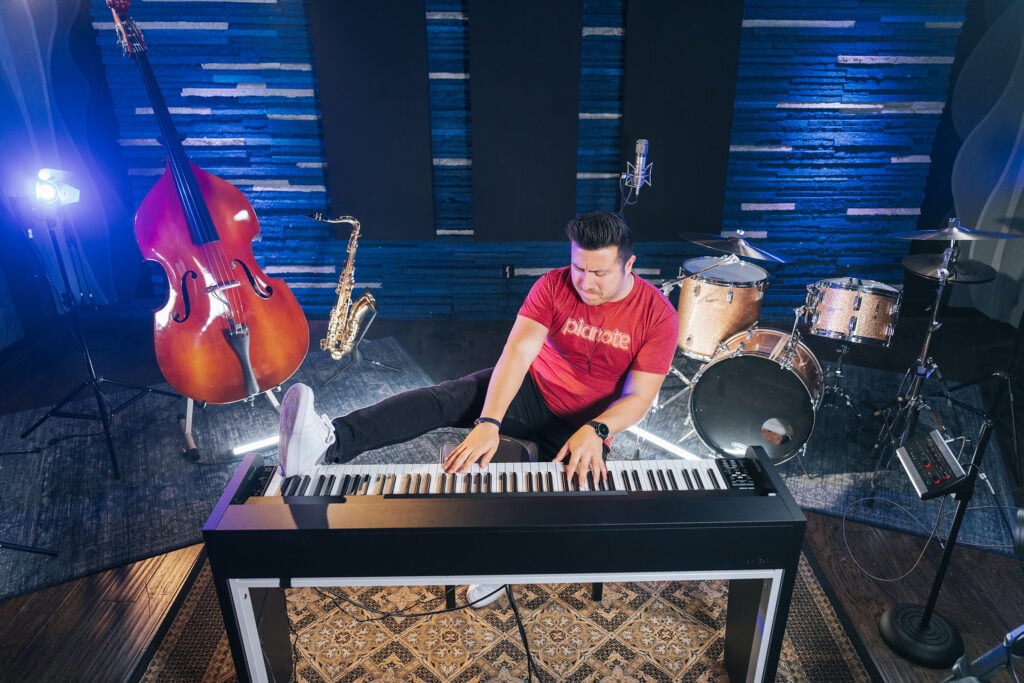
If you’ve ever seen a jazz or cocktail lounge pianist play, you may have found it a magical, surreal experience. Jazz is rooted in improvisation, so how the heck do these brilliant musicians conjure up delightful melodies seemingly from thin air?
Well, it’s not exactly magic. Jazz pianists have a very solid grasp of chord theory which gives them shortcuts to improvise upon. If you want to get started with jazz, we recommend learning seventh chords, understanding the ii-V-I progression, and mastering syncopation. Then, start adding riffs and licks to your jazz back pocket.
If you’re a Pianote Member, check out our in-depth series on “Autumn Leaves.”

We’ve noticed that topics about playing piano for a religious community are among some of our most popular content. Which is awesome because music is all about community!
Playing for your place of worship can be incredibly rewarding because you get to be part of a team. Collaboration takes practice, and playing with a band builds very useful skills.

When most people think of piano, they think of classical music.
The piano has been a mainstay in classical music for centuries. And people like Chopin, Liszt, and Debussy have defined what many people imagine as the “piano sound.”
Classical music is often considered more advanced because you need to be pretty comfortable reading sheet music. (Even though, contrary to popular belief, classical music has a rich improvisation history!)

Playing pop music is fun because, for many of us, pop music is what we listen to on a daily basis. You know these songs in and out.
The advantage of playing pop music is you can make songs as simple or as complicated as you’d like. You can see this in action with Lisa’s “5 Levels of ‘Tiny Dancer'” video. You can also choose to play along to your own singing or play the melody on the piano.
We have tons of pop piano tutorials on this website, so make sure to check them out!
Playing piano can get expensive.
Fortunately, thanks to the internet, there are numerous free ways to develop skills, play your favorite songs, and master music theory. Here are several 100% free online resources to help with your journey.
Piano Dreamers is a super in-depth blog that covers piano learning options and gear. They write very detailed articles like The Ultimate Guide to Buying a Digital Piano and product reviews for keyboards, recording equipment, learning methods, and more.
Piano Buyer is a biannual publication that covers what’s new and hot in the piano-buying market. It is accessible for free on the internet and includes in-depth articles on subjects like how to best buy used instruments.

The Petrucci Music Library a.k.a. the International Music Score Library Project (IMSLP) is an online database of (mostly) public domain sheet music from classical composers like Bach, Beethoven, Chopin, and Mozart, whose sheet music copyright has expired.
8notes is a library of sheet music for popular tunes, arranged for beginners.
Ultimate-Guitar.com contains chord charts for piano, guitar, bass, and ukulele. Chord charts can be toggled to “piano” to show diagrams of how to play each chord.
Audacity is a free, open-source, multi-platform recording software that allows you to record and edit music.
Musescore is a free sheet music writing program with powerful features.
The Note (this blog!) – okay, we’re a little biased here. But we work every day to make The Note the best free piano learning resource on the web. You’ll find tons of resources including song tutorials, technical exercises, theory explanations and in-depth articles like biographies of famous pianists.
YouTube is another great resource. Content creators on YouTube, from major companies to individual pianists, make how-to videos every day. These include everything from song tutorials to mini-documentaries that explain the theory behind your favorite compositions.
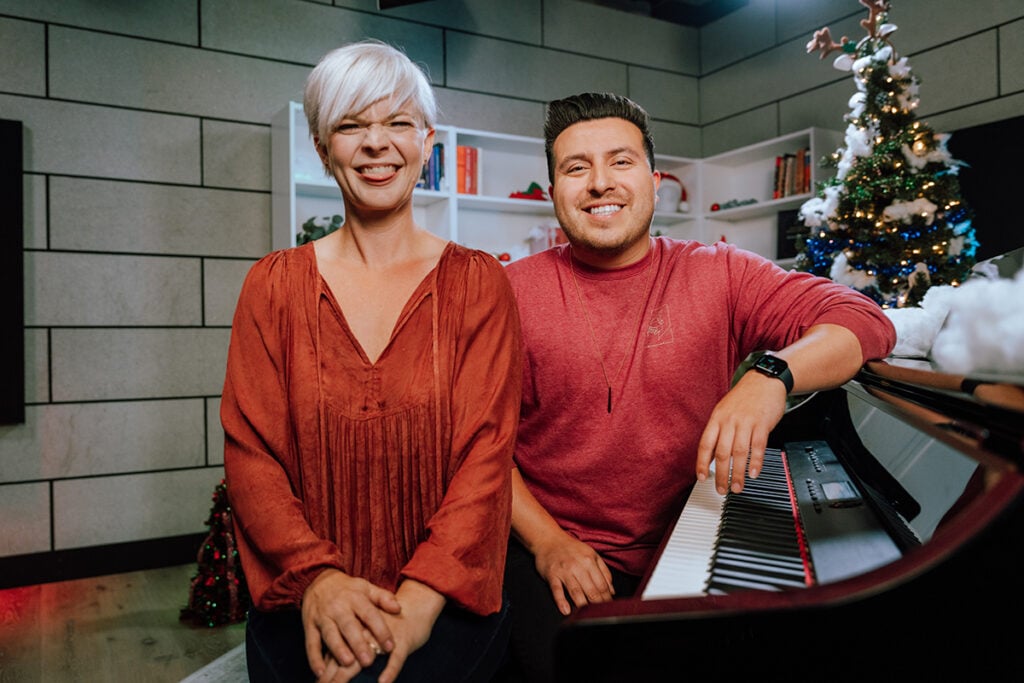
The piano is a pretty self-sufficient, independent instrument. Unfortunately, this means pianists can be isolated.
But communities are great resources because if you’re struggling with something, you can consult with your community. Perhaps someone else has been there, solved that.
That all being said, finding a community isn’t always easy especially with pianists, because pianos aren’t exactly portable. However, there are numerous online communities that are great resources:
You can also upload videos of your playing online and request feedback.
We’re very passionate about community at Pianote partly because we share a studio with drummers, guitarists, and other musicians and we’ve seen first-hand the value of collaboration.
That’s why we created the Pianote Members Area as a place for students to learn piano together. Pianote members can also attend live Q&A sessions, post discussions in the forum, and share content in a private Facebook group.
If you’re not sure about committing to a membership, you can take a look behind the paywall here.

If you’re excited to learn piano but are bursting with questions, you’ve come to the right place!
No! In fact, we think age is an advantage.
Adults tend to have established work habits and are often very driven to learn music. After all, you’re taking music lessons for yourself, not a parent or teacher!
As an adult, you’ve also had lifelong exposure to music. You understand rhythm, melody, and may even be able to figure out tunes by ear.
So try learning piano. If anything, the health benefits are excellent reasons to start. As is your passion to create music.
> Learning Piano As An Adult: Tips & Exercises
Some of the most successful musicians ever, including all the Beatles, don’t know how to read music. And Mozart was famous for being able to recreate songs by ear. So, short answer: no.
That being said, knowing how to read music is an incredibly useful skill. Sight-reading is encouraged if you want to play classical music you’re essentially recreating a song exactly how it was written.
However, if you want to play pop music, knowing how to read chord charts should be enough. Sheet music is useful, but it can also limit your creativity. On the other hand, chord charts and lead sheets encourage original improvisation while providing guidance.
At the end of the day, pick a learning method that is rewarding for you and your musical preferences.
How and what to practice is a common question we get. You’ve probably heard stories of professional pianists who practice an insane number of hours, but how you practice is more important than how many hours you put in.
Practice with a plan and have goals in mind. A typical practice session may go like this:
It’s also more effective and efficient to target things you struggle with, rather than playing songs from beginning to end, over and over again.
Consistency is also important. It may be more effective to practice 10 minutes a day, every day, than one hour of binge-practicing and then no practice for the rest of the week.
> Practice Routine for Absolute Beginners
This is a very common problem for pianists of all ages. Even experienced pianists struggle with hand independence from time to time.
Struggling is actually a good sign — it means you’re challenging yourself to learn something new. Just keep practicing — it takes time. If a hand independence exercise comes too easily to you, it means it’s too easy!
Try to get an 88-key keyboard (or at least 61 keys), and make sure the keys are touch-sensitive. This means if you press on them lightly, you’ll make a soft sound. And if you press on them hard, you’ll play hard.
Lisa also has a curated list of trustworthy products you can browse. For beginners, we recommend the Yamaha P125 and Roland FP30, which are both
This is a difficult question to answer because it depends on so many different things: your definition of “good,” how much you practice, and how you practice.
One thing is for sure, though: just because someone can play an impressive-looking song, doesn’t mean they are a good pianist.
But to answer the question, you can learn basic skills pretty quickly if you’re diligent. In fact, you can go from never having touched a piano to playing “Imagine” in seven days.
Progressing from there is a matter of time and dedication. If ever feel frustrated, you’re not alone! There are ways to re-motivate yourself, such as re-visiting why you want to learn how to play the piano.
> How Long Does It Take to Learn Piano? We Asked 1000+ Pianists
We hope this guide jumpstarts your piano journey! Honestly, though, we’re so happy you’re here. Welcome to the piano family!
Get real feedback from real experts…all from the comfort of your own home. Explore our Method and community for yourself with a free trial.
*This article contains affiliate links, which means we might earn a small commission from the product seller if you make a purchase. For more info, check out our privacy page.
Charmaine Li is a Vancouver writer who has played piano for over 20 years. She holds an Associate diploma (ARCT) from the Royal Conservatory of Music and loves writing about the ways in which music—and music learning—affects the human experience. Charmaine manages The Note. Learn more about Charmaine here.
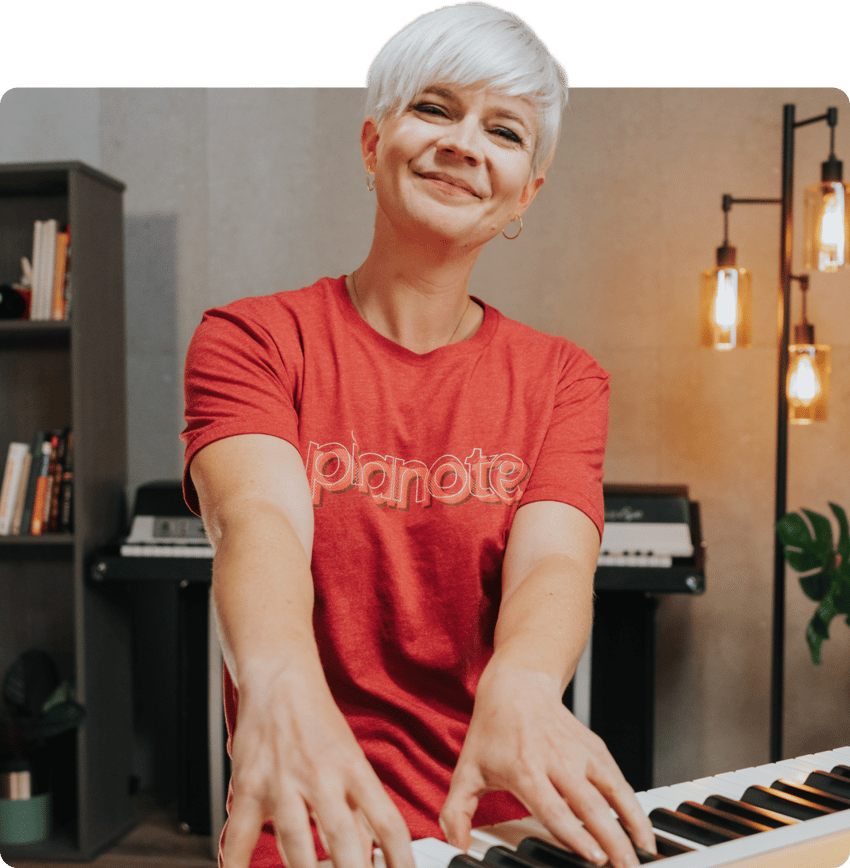

By signing up you’ll also receive our ongoing free lessons and special offers. Don’t worry, we value your privacy and you can unsubscribe at any time.
We use cookies for traffic data and advertising. Cookie Policy »